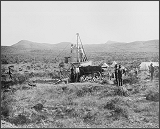Teaching With Documents:
The Treaty of Guadalupe Hidalgo
Background
The Treaty of Guadalupe Hidalgo (gwah-dah-loop-ay ee-dahl-go), which brought an official end to the Mexican-American War (1846-1848) was signed on February 2, 1848, at Guadalupe Hidalgo, a city north of the capital where the Mexican government had fled with the advance of U.S. forces. To explore the circumstances that led to this war with Mexico, visit the Teaching with Documents lesson, "Lincoln's Spot Resolutions."
With the defeat of its army and the fall of the capital, Mexico City, in September 1847 the Mexican government surrendered to the United States and entered into negotiations to end the war. The peace talks were negotiated by Nicholas Trist, chief clerk of the State Department, who had accompanied General Winfield Scott as a diplomat and President Polk's representative. Trist and General Scott, after two previous unsuccessful attempts to negotiate a treaty with Santa Anna, determined that the only way to deal with Mexico was as a conquered enemy. Nicholas Trist negotiated with a special commission representing the collapsed government led by Don Bernardo Couto, Don Miguel Atristain, and Don Luis Gonzaga Cuevas of Mexico.
In The Mexican War, author Otis Singletary states that President Polk had recalled Trist under the belief that negotiations would be carried out with a Mexican delegation in Washington. In the six weeks it took to deliver Polk's message, Trist had received word that the Mexican government had named its special commission to negotiate. Against the president's recall, Trist determined that Washington did not understand the situation in Mexico and negotiated the peace treaty in defiance of the president. In a December 4, 1847, letter to his wife, he wrote, "Knowing it to be the very last chance and impressed with the dreadful consequences to our country which cannot fail to attend the loss of that chance, I decided today at noon to attempt to make a treaty; the decision is altogether my own."
In Defiant Peacemaker: Nicholas Trist in the Mexican War, author Wallace Ohrt described Trist as uncompromising in his belief that justice could be served only by Mexico's full surrender, including surrender of territory. Ignoring the president's recall command with the full knowledge that his defiance would cost him his career, Trist chose to adhere to his own principles and negotiate a treaty in violation of his instructions. His stand made him briefly a very controversial figure in the United States.
Under the terms of the treaty negotiated by Trist, Mexico ceded to the United States Upper California and New Mexico. This was known as the Mexican Cession and included present-day Arizona and New Mexico and parts of Utah, Nevada, and Colorado (see Article V of the treaty). Mexico relinquished all claims to Texas and recognized the Rio Grande as the southern boundary with the United States (see Article V).
The United States paid Mexico $15,000,000 "in consideration of the extension acquired by the boundaries of the United States" (see Article XII of the treaty) and agreed to pay American citizens debts owed to them by the Mexican government (see Article XV). Other provisions included protection of property and civil rights of Mexican nationals living within the new boundaries of the United States (see Articles VIII and IX), the promise of the United States to police its boundaries (see Article XI), and compulsory arbitration of future disputes between the two countries (see Article XXI).
Trist sent a copy to Washington by the fastest means available, forcing Polk to decide whether or not to repudiate the highly satisfactory handiwork of his discredited subordinate. Polk chose to forward the treaty to the Senate. When the Senate reluctantly ratified the treaty (by a vote of 34 to 14) on March 10, 1848, it deleted Article X guaranteeing the protection of Mexican land grants. Following the ratification, U.S. troops were removed from the Mexican capital.
To carry the treaty into effect, commissioner Colonel Jon Weller and surveyor Andrew Grey were appointed by the United States government and General Pedro Conde and Sr. Jose Illarregui were appointed by the Mexican government to survey and set the boundary. A subsequent treaty of December 30, 1853, altered the border from the initial one by adding 47 more boundary markers to the original six. Of the 53 markers, the majority were rude piles of stones; a few were of durable character with proper inscriptions.
Over time, markers were moved or destroyed, resulting in two subsequent conventions (1882 and 1889) between the two countries to more clearly define the boundaries. Photographers were brought in to document the location of the markers. These photographs are in Record Group 77, Records of the Office of the Chief Engineers, in the National Archives. An example of one of these photographs, taken in the 1890s, is available online through the Archival Research Catalog (ARC) database, identifier: 519681 .
The Documents
View: Cover | Page 1 | Signature Page
National Archives and Records Administration
General Records of the United States
Record Group 11
ARC Identifier: 299809

Click to Enlarge
National Archives and Records Administration
Records of the Office of the Chief Engineers
Record Group 77
ARC Identifier: 519682
Article Citation
This article was written by Tom Gray, a teacher at DeRuyter Central Middle School, in DeRuyter, NY.

